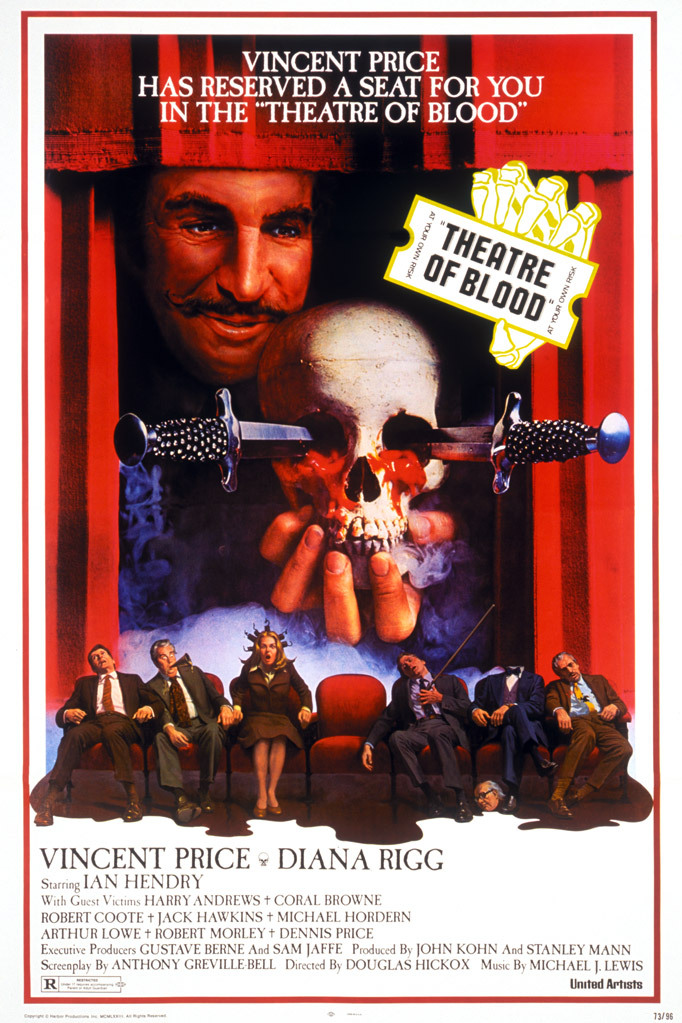
Film Editor James Richards revisits Douglas Hickox’s Theatre of Blood, finding it to be just as camp and vivacious as it was upon release in 1973
Content warning: suicide
Vincent Price’s career spanned seven decades and over one hundred films – yet 1973’s Theatre of Blood, he often said, was a particular highlight. The debonair horror icon had always wanted to perform Shakespeare and in Theatre of Blood (celebrating its fiftieth anniversary this year), he had finally gotten his chance. The fact that Theatre is an ultraviolent comedy horror does not diminish the film’s status as one of Price’s best. If anything… it enhances it.
Theatre of Blood is satisfying, pacy and above all, camp as Christmas. Price stars as Edward Lionheart, a flamboyant thesp hounded by the members of the Theatre Critics Guild for his refusal to play anything other than Shakespeare. After losing a key award to a Brando-esque upstart (in Lionheart’s words, ‘a twitching, mumbling boy who can barely grunt his way through an incomprehensible performance’), Lionheart commits apparent suicide by jumping into the River Thames.
He survives, of course. The washed-up actor finds himself literally washed up on the riverbank, where he meets with a troupe of murderous outcasts. Two years pass… and Lionheart starts to enact bloody revenge on the toffee-nosed critics who once scorned him. Aided by an entourage that includes his loyal daughter Edwina (the late Diana Rigg, on superb form), Lionheart kills each of his victims in a manner inspired by one of William Shakespeare’s plays. One critic is drowned in a vat of wine just like Clarence in Richard III; another is stabbed by a mob (on the Ides of March, no less), à la the title character of Julius Caesar. With each murder, Lionheart triumphantly recites lines from the Shakespeare play that inspired the act. This winning formula is what carries the whole film.
Theatre of Blood wastes no time in getting its body count started. The first critic kicks the bucket less than ten minutes in and zero preamble is given – any necessary backstory is expressed through later flashbacks. The murders, naturally, are front and centre. With a pace that most other horror movies would kill for, Theatre dispatches its victims at a mechanical rate: roughly one every ten minutes. The whole thing is a treat for slasher fans: both figuratively and literally, Vincent Price silences his critics (forever).
“The whole thing is a treat for slasher fans: both figuratively and literally, Vincent Price silences his critics (forever)
The subplots are deftly handled too. Storylines like the police investigation (always one step behind) could have easily pulled focus in less capable hands. Luckily, director Douglas Hickox’s hands are as practised in murder as Lady Macbeth’s; the man imbues the film with lashings of lurid charm, courtesy of Get Carter (1971) cinematographer Wolfgang Suschitzky. Diana Rigg’s performance is another highlight: the star is more than capable of holding her own against Price – as the Cordelia to Lionheart’s Lear.
Through its blend of grisly yet absurd violence, Theatre of Blood spans the Shakespearean genres of both comedy and tragedy. Time, however, has also placed the film into that third Shakespearean category… the history play. Hickox’s film displays delightful amounts of early-1970s kitsch: the costumes in particular are a highlight. One Theatre of Blood anecdote involves star Coral Browne, who requested that her character (critic Chloe Moon) wear only outfits created by designer Jean Muir. Costume designer Michael Baldwin turned this pricy request down… that is until director Hickox upped the film’s budget solely to get Browne the designer costumes she wanted. Once filming wrapped, Browne even ended up keeping the outfits. Killer style.

Though firmly rooted in its period, Theatre of Blood also has one eye on the future. It’s no real surprise that the blu-ray for Theatre of Blood comes with a commentary by Mark Gatiss, Steve Pemberton and Reece Shearsmith of The League of Gentlemen: the group owe Theatre a great debt. The film’s particular brand of hammy horror informs much of the group’s work from The League of Gentlemen (1999-2017) itself, to Pemberton and Shearsmith’s Inside No. 9 (since 2014), or even Gatiss’ campy contributions to Doctor Who (since 2005). But Theatre of Blood’s influence doesn’t even stop there. Across the pond, would the novelty-murder shenanigans of Se7en (1995) have even been conceived without the influence of Vincent Price?
The same could also be said for other Price classics like The Abominable Dr. Phibes (1971). What truly distinguishes Theatre of Blood is its genuine Shakespearean credentials. Hickox’s comedy of terrors draws from all corners of the Shakespearean canon: even obscure late tragicomedy Cymbeline (last seen this year at the RSC) gets a look-in. For his third murder, Lionheart decapitates a critic, then leaves the man’s body for his sleeping wife to find: a similar fate is suffered by the villainous Cloten in Cymbeline. Of course, Price and Rigg deliver Cymbeline’s ‘Fear no more the heat o’ the sun’ speech with characteristic grace.
“Lionheart’s stagily earnest delivery seems rooted in some century earlier than the twentieth
The actor got his wish in the end. If Vincent Price had always wanted to perform Shakespeare, then Theatre of Blood gave him the perfect opportunity… an opportunity to meld Grand Guignol horror with more elevated Shakespearean trappings. When Price recites Hamlet’s famous ‘To be, or not to be’ soliloquy, for instance, the feeling of pathos is very real. Lionheart’s stagily earnest delivery seems rooted in some century earlier than the twentieth: more John Philip Kemble than John Gielgud. But that is precisely the point. In this moment, Price plays Lionheart playing Hamlet and unlike his fictional counterpart, he delivers the lines without a shred of ego in sight. This is a performance that has been fine-tuned for the big screen, not the Royal Shakespeare Theatre.
That the star’s finest role would be in a movie like Theatre of Blood feels fitting. The film’s blend of high and low, tragedy and comedy, stage and reality is so compelling, so enduring; and so deeply British. On its fiftieth anniversary, give Theatre of Blood a watch… if you dare.
Theatre of Blood is available to stream now.
In the mood for something scary? Check out these horror-related features from Redbrick Film:
Review: Talk to Me | Redbrick Film
The Influence of the Nuclear Bomb on Japanese Cinema | Redbrick Film

Comments